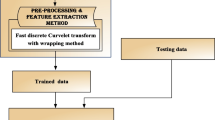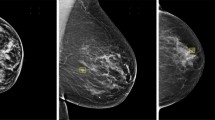Abstract
Mammography technique is commonly used for diagnosing breast cancer, but mammography images usually show low contrast which cause difficulties to clinical diagnosis. Therefore, improving the visual quality of mammography images is an important issue. This is a challenging problem, because every mammography image consists of rich textures, including bright areas, dark areas, and textural details. Inspired by bio-inspired neural network, this paper proposes a Bidirectional Spiking Cortical Model (Bi-SCM) from the perspective of neural information fusion to enhance the contrast of bright areas and dark areas adequately, as well as textural details. This goal is achieved by utilizing the Bi-SCM to first enhance a mammography image and its inverse separately. The enhanced results are fused by a new fusion algorithm based on non-subsampled contourlet transform (NSCT) to ensure that both of the contrast of bright areas and dark areas are adequately improved. The textual details are then enhanced by an unsharp masking method which consists of cubic filter and log-ratio operation. Sufficient experiments on mammography images are conducted to evaluate the proposed approach. Experimental results show that the proposed method outperforms state-of-the-art methods on both enhancing contrast and details. Besides, over-enhancement and noise sensitivity are also significantly suppressed.








Similar content being viewed by others
Data Availability
The datasets analysed during the current study are available at https://www.mammoimage.org/databases/and http://www.eng.usf.edu/cvprg/Mammography/Database.html.
References
Agaian SS, Panetta K, Grigoryan AM (2001) Transform-based image enhancement algorithms with performance measure. IEEE Trans Image Process 10(3):367–382
Bhatnagar G, Wu QMJ, Liu Z (2009) Directive contrast based multimodal medical image fusion in NSCT domain. IEEE Trans Multimedia 20 (12):1980–1986
Celik T, Tjahjadi T (2012) Automatic image equalization and contrast enhancement using Gaussian mixture modeling. IEEE Trans Image Process 21(1):145–156
Chen S-D, Ramli A (2003) Minimum mean brightness error bi-histogram equalization in contrast enhancement. IEEE Trans. Consum Electron 49 (4):1310–1319
Diwakar M, Kumar M (2018) A review on CT image noise and its denoising. Biomed Signal Process Control 42:73–88
Diwakar M, Kumar P (2019) Wavelet packet based CT image denoising using bilateral method and Bayes Shrinkage rule. In: Handbook of Multimedia Information Security, pp 501-511
Diwakar M, Kumar P (2020) Blind noise estimation-based CT image denoising in tetrolet domain. Int J Inf Comput Secur 12(2/3):234–252
Diwakar M, Kumar P, Singh AK (2020) CT Image denoising using NLM and its method noise thresholding. Multim Tools Appl 79(21-22):14449–14464
Diwakar M, Singh P (2020) CT Image denoising using multivariate model and its method noise thresholding in non-subsampled shearlet domain. Biomed Signal Process Control 571(57):101754
Diwakar M, Sonam M (2015) Kumar CT image denoising based on complex wavelet transform using local adaptive thresholding and Bilateral filtering. In: Proc Int Symposium on Women in Computing and Informatics, pp 297–302
Diwakar M, Verma A, Lamba S, Gupta H (2018) Inter- and Intra-scale Dependencies-Based CT Image Denoising in Curvelet Domain. In: Proc Soft Computing Theories and Applications. Advances in Intelligent Systems and Computing, pp 343–350
Deng G (2011) A generalized unsharp masking algorithm. IEEE Trans Image Process 20(5):1249–1261
Eckhorn R (1990) Feature linking via Synchro-nization among distributed assembles: simulations of results from cat visual cortex. Neural Comput 2:293–307
Eltoukhy MM, Faye I, Samir BB (2008) A comparison of wavelet and curvelet for breast cancer diagnosis in digital mammogram. Comput Biol Med 40 (4):384–391
Fechner GT (1860) Elemente der psychophysik, 1st ed. Bre-itkopf & Hartel, Leipzig
Gao X, Wang Y, Li X, Tao D (2010) On combining morphological component analysis and concentric morphology model for mammographic mass detection. IEEE Trans Inf Technol Biomed 14(2):266–273
Ghita O, Ilea DE, Whelan PF (2013) Texture enhanced histogram equalization using TV − l1 image decomposition. IEEE Trans Image Process 22(8):3133–3144
Hautière N, Tarel J-P, Aubert D, Dumont E (2011) Blind contrast restoration assessment by gradient rationing at visible edges. Image Anal Stereol 27(2):87–95
Heath M, Bowyer K, Kopans D, Moore R (2001) The digital database for screening mammography. In: Proc 5th Int Workshop Digital Mammography, pp 212–218
Hu K, Gao X, Li F (2011) Detection of suspicious lesions by adaptive thresholding based on multiresolution analysis in mammograms. IEEE Trans Instrum Meas 60(2):462–472
Jung S-W (2014) Image contrast enhancement using color and depth histograms. IEEE Signal Process Lett 21(4):382–385
Kim YT (1997) Contrast enhancement using brightness preserving bi-histogram equalization. IEEE Trans Consum Electron 43(1):1–8
Lakshmanan R, Thomas V (2012) Enhancement of microcalcification features using morphology and contourlet transform. In: Proc Int Conf advances in Comput and Commun Cochin, pp 14–17
Lu Z, Jiang T, Hu G, Wang X (2007) Contourlet based mammographic image enhancement. In: Proc Int Conf Photonics and Imaging in Biology and Medicine, Wuhan, pp 65340M-1-65340M-8
Ma Y, Teng F, Zhan K, Zhang H (2012) A new method of color image enhancement using spiking cortical model. Journal of Beijing University of Posts and Telecomminications (Chinese) 35(3):70–73
Mai C, Nguyen M, Kwok N (2011) A modified unsharp masking method using particle swarm optimization. In: Proc Int Cong Image and Signal Processing, Shanghai, pp 646–650
Panetta K, Zhou Y, Agaian S, Jia H (2011) Nonlinear unsharp masking for mammogram enhancement. IEEE T Inf Technol Biomed 15(6):918–928
Petrovic V (2007) Subjective tests for image fusion evaluation and objective metric validation. Inf Fusion 8(2):208–216
Pizer SM, Amburn EP, Austin JD, Cromartie R, Geselowitz A, Greer T, Romeny BTH, Zimmerman JB (1987) Adaptive histogram equalization and its variations. Comput Vis Graph 39(3):355–368
Polesel A, Ramponi G, Mathews VJ (2000) Image enhancement via adaptive unsharp masking. IEEE Trans Image Process 9(3):505–510
Qu G, Zhang D, Yan P (2001) Medical image fusion by wavelet transform modulus maxima. Opt Express 9(4):184–190
Qu G, Zhang D, Yan P (2002) Information measure for performance of image fusion. Electron Lett 38(7):313–315
Qu X, Yan J-W, Yang G-D (2009) Sum-modified-laplacian-based multifocus image fusion method in sharp frequency localized contourlet transform domain. Opt Precision Eng 17(5):1203–1212
Rahman Z, Jobson DJ, Woodell GA (1996) Multi-scale retinex for color image enhancement. In: Proc Int Conf Image Processing, Lausanne, pp 1003–1006
Ramponi G (1998) A cubic unsharp masking technique for contrast enhancement. Signal Process 67(2):212–222
Ramponi G, Polesel A (1998) Rational unsharp masking technique. J Electron Imag 7(2):333–338
Ranganath HS, Kuntimad G, Johnson JL (1995) Pulse coupled neural networks for image processing. In: Proc IEEE Southeastcon, Raleigh, NC, pp 37–43
Sheet D, Garud H, Suveer A, Mahadevappa M, Chatterjee J (2010) Brightness preserving dynamic fuzzy histogram equalization. IEEE Trans Consum Electron 56(4):2475–2480
Stewart DE, Cheung AM, Duff S, Wong F, McQuestion M, Cheng T, Purdy L, Bunston T (2001) Attributions of cause and recurrence in long-term breast cancer survivors. Psychooncology 10(2):179–183
Suckling J, Parker J, Astley S, Hutt I, Boggis C, Ricketts I, Stamatakis E, Cerneaz N, Sl K, Taylor P, Betal D, Savage J (1994) The mammographic image analysis society digital mammogram database. In: Proc 2nd Int Workshop Digital Mammography, pp 375–378
Sun X, Du J, Li Q, Li X (2013) Improved energy contrast image fusion based on nonsubsampled contourlet transform. In: Proc IEEE int conf industrial electronics and applications, Melbourne, VIC, pp 1610–1613
Toet A, Van Ruyven LJ, Valeton JM (1989) Merging themal and visual images by a contrast Pyramid. Opt Eng 28(7):789–792
Wang Z, Ma Y (2008) Medical image fusion using m-PCNN. Inf Fusion 9(2):176–185
Xing S-X, Chen T-H, Li J-X (2010) Image fusion based on regional energy and standard deviation. In: Proc Int Conf signal process Systems, Dalian, pp V1-739-V1-743
Xiao X, Zhang X (2010) An improved unsharp masking method for borehole image enhancement. In: Proc Int Conf Industrial Mechatronics and Automation, Wuhan, pp 349–352
Xydeas CS, Petrovic V (2000) Objective image fusion performance measure. Electron Lett 36(4):308–309
Zhan K, Zhang H, Ma Y (2009) New spiking cortical model for invariant texture retrieval and image processing. IEEE Trans Neural Netw 20(12):1980–1986
Acknowledgments
This work was jointly supported by the National Natural Science Foundation of China under grant 62001110, the Natural Science Foundation of Jiangsu Province under grant BK20200353, andthe 111 Project under grant B17040.
Author information
Authors and Affiliations
Corresponding author
Ethics declarations
Conflict of Interests
The authors declare that they have no conflicts of interest.
Additional information
Publisher’s note
Springer Nature remains neutral with regard to jurisdictional claims in published maps and institutional affiliations.
Rights and permissions
Springer Nature or its licensor holds exclusive rights to this article under a publishing agreement with the author(s) or other rightsholder(s); author self-archiving of the accepted manuscript version of this article is solely governed by the terms of such publishing agreement and applicable law.
About this article
Cite this article
Yan, Y., Zhang, H., Du, S. et al. Bi-SCM: bidirectional spiking cortical model with adaptive unsharp masking for mammography image enhancement. Multimed Tools Appl 82, 12081–12098 (2023). https://doi.org/10.1007/s11042-022-13766-3
Received:
Revised:
Accepted:
Published:
Issue Date:
DOI: https://doi.org/10.1007/s11042-022-13766-3




